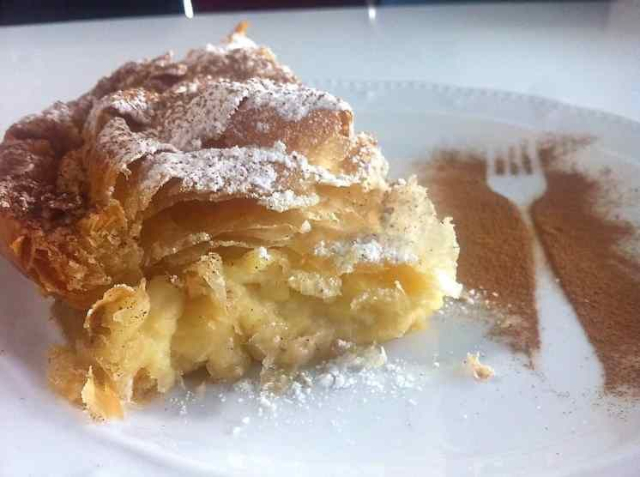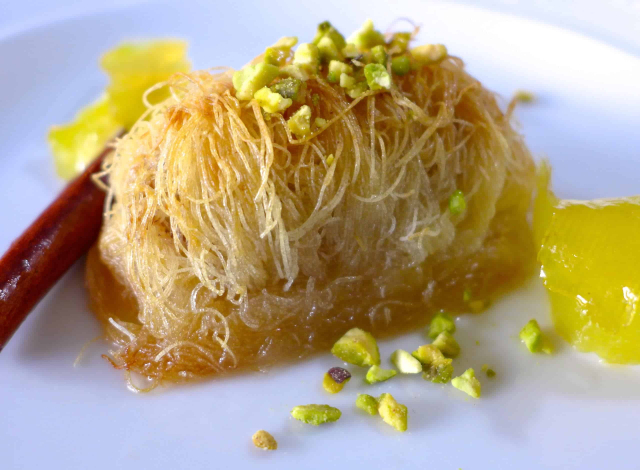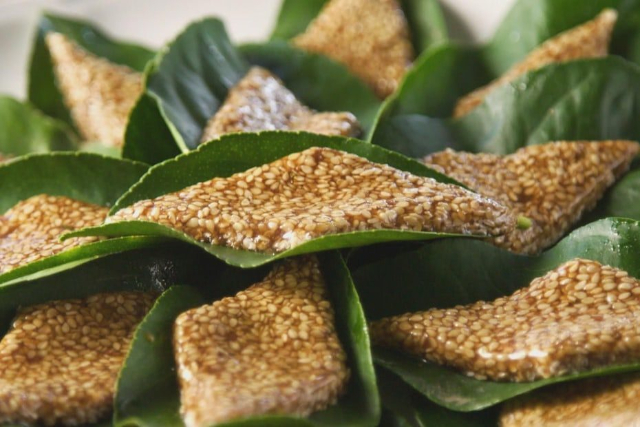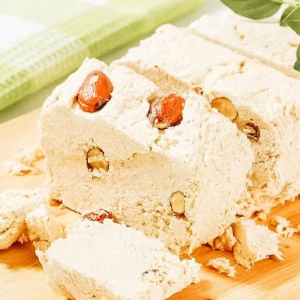Yesterday, we looked at the most popular Greek dishes – both well-known and relatively unknown. Today. we’ll delve into the world of Greek desserts and baked goods – a realm largely dependent on wheat flour and honey. Like many of the main dishes we explored yesterday, Greek desserts share a heritage with West Asian and Middle Eastern cuisines…
 Classic Geek Baklava: One of best-known Greek Desserts. Also found,
Classic Geek Baklava: One of best-known Greek Desserts. Also found,
in other distinct versions, in other Eastern Med cuisines…
We know that a great sharing of food styles and ingredients took place around the eastern Mediterranean during the supremacy of the Byzantine Empire (approx. 330 ce to 1450 ce). Similarities between dishes still enjoyed today in a dozen different countries prove the point. Even a brief examination of the traditional Greek dessert table confirms close historical ties to cultures as far distant as Iraq.
Also as in many other eastern Mediterranean cultures, sweets claim a prominent place on the Greek national menu.
On our menu today…
Amygdalota: These gluten-free Almond Cookies are traditionally made with ground almonds alone – no wheat flour – and, so, are naturally gluten-free. The other ingredients are simply eggs, sugar, orange zest and a little salt.

Almonds are plentiful in Greece – as in most other eastern Med countries – and are considered to bring good luck. That’s why you’ll see Amygdalota at most special occasions, such as weddings, birthdays and christenings.
Baklava: Most of us are familiar with the pan-Middle Eastern favourite Baklava. It’s simply layers of phyllo pastry alternated with layers of nuts and sweet spices. Greek Baklava features walnuts (chopped) and honey, in contrast to Turkish style Baklava, which uses sugar syrup and pistachios. The secret to keeping the pastry crispy is to add the sweet syrup or honey after the dish is baked. This is just one of the many ‘syrupy’, or ‘siropiasta’, desserts Greeks love so much.
Bougatsa: A sort of pie made from phyllo pastry with a custard filling. It’s a commonly-found street food topped with powdered sugar and cinnamon.

Greeks eat it anytime, for desert with meals or as a hand-snack. Like Amygdalota, it’s great with a cup of coffee.
Feta Mei Meli: Feta Cheese wrapped in phyllo pastry and baked. It’s served with honey poured on top and a sprinkling of sesame or poppy seeds.
Galaktoboureko: This is simply Greek custard pie. A custard base is poured onto a phyllo bottom crust and more phyllo is used for the top crust.

The phyllo is brushed generously with melted butter at all stages of the dish’s assembly, and the finished pie is drizzled with melted butter and rosewater- or orange-infused syrup. This authentic recipe goes into essential detail about prepari9ng the classic Greek custard filling.
Greek Halva: Here is the dessert of your dreams – unless you’re allergic to nuts. It contains no dairy, no butter and no eggs. All it takes to make Greek Halva are vegetable oil, semolina, sugar and water. And nuts, if you’re amenable – usually almonds. Like other versions of Halva, it’s either formed into a roll and cut in rounds, or spread evenly in a greased pan to set, then cut into squares. (See photo, top of page.)
Kataifi: The name refers to the type of pastry used in this pie-like dessert. A welcome (?) break from phyllo? Well, Kataifi is actually shredded phyllo, superficially resembling shredded wheat – made up of hundreds of thin strands.

You have to be careful handling Kataifi, and this recipe provides helpful hints for producing a successful pie. The filling is traditionally composed of chopped walnuts, cinnamon and cloves. Drizzle the pastry with lot of butter and splash generously with lemon-infused sugar syrup.
Loukoumades: And now for something completely different (quoth Monty Python) – little deep-fried, yeast-raised doughnuts sprinkled with or rolled in syrup, finely chopped walnuts and cinnamon. They’ll remind you a little of the doughnut holes served by most North American doughnut shops, but be forewarned: they’re flavoured with olive oil. Now that’s something different!
Pasteli: The best way to describe this cookie/candy is as a wafer made up mainly of sesame seeds and honey to bind them together. Other nuts are sometines used to provide variety.

Your first sight of Pasteli will remind you of the energy bars sold everywhere i Europe and North America. Greeks think of them as ‘the original energy bar’, and consume them for a lift at low-energy times of the day. They’re great with tea or coffee, or just as a hand snack.
Coffee specialties
Ellinikos: Tradition Greek Coffee made and served in a manner very similar to Turkish Coffee. There go the shared influences again! And like Turkish coffee, you can order it to your taste: Vari Glyko (strong and full-sweet), Metrios (medium sweet) and Sketos (black). It’s made in traditional o0ong-handled single-serving copper pots known as biriki.
Frappe: The word looks French (as it is a word in French!) but it means something completely different in Greek cuisine. This is an iced coffee drink enjoyd on the hottest days of summer. You just combine instant coffee crystals with cold water and ice and give it a good ride in a cocktail shaker.

Frappe has a colourful and intriguing history:
“Greek frappe or Nescafé frappe was invented in 1957 in Thessaloniki at the International Trade Fair, where Yannis Dritsas, the representative of the Nestlé Company, was exhibiting a new product for children [Nestlé’s Quick!]. The product was a chocolate beverage, which was produced instantly by mixing with milk and shaking in a shaker. […] Dimitris Vakondios (Dritsas’ employee) was looking for a way to make hot instant coffee during his break, but couldn’t find hot water. So he decided to mix […] instant coffee with cold water and ice cubes in a shaker.”
Frappe is traditionally consumed unsweetened, but there’s nothing to say you can’t embellish it to your heart’s content. It’s one of those ‘dishes’ that’s more a technique than a recipe, a jumping-off place for your sense of creativity!
Greek wines
Greek wines: They’re traditionally strong and relatively high in alcohol. Likewise, they’re big on flavour, and are consumed in generous amounts with most meals. Along with neighbouring Bulgaria, Greece boasts an ages-old wine tradition which today produces some of the most sought-after Med-region vintages. Unlike the famous vintages of France and other Western European countries, Greek and Bulgarian wines are generally modestly priced – a good, often great value!
Retsina: You haven’t ‘tasted Greece’ until you’ve had a glass of Retsina. It’s a white or rosé wine made from Savatiano grapes blended with Assyrtiko and Rhoditis. Retsina gets its name from the ancient Greek tradition of sealing wine jugs with pine resin to keep the air out and prevent spoilage during transport and storage. The piney essence insinuated itself in the wine over time. Drinkers report a slight ‘tinge’ of resinous flavour and aroma. Some even claim they detect lemon, but there’s no lemon essence in it. Retsina is specific to Greece and is protected by a European Union place-of-origin statute. A wine can only be called Retsina if is made using the original 2,000-year-old technique, in an area composed of Greece and parts of Cyprus. Similar wines produced elsewhere must be called ‘resinated’.
Opa!
Give Greek cuisine a cheer! And don’t be afraid to try making some of the delightful Greek dishes we’ve brought you over the past couple of days. Next time, we’ll take a look at another equally-ancient Eastern Med cuisine: Macedonian!
~ Maggie J.

